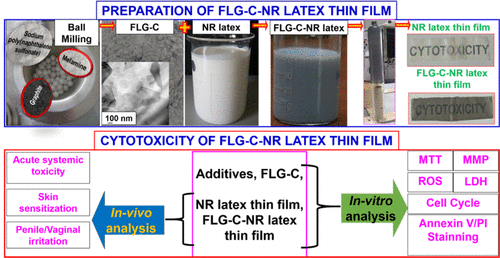当前位置:
X-MOL 学术
›
ACS Biomater. Sci. Eng.
›
论文详情
Our official English website, www.x-mol.net, welcomes your
feedback! (Note: you will need to create a separate account there.)
Cytotoxicity of Formulated Graphene and Its Natural Rubber Nanocomposite Thin Film in Human Vaginal Epithelial Cells: An Influence of Noncovalent Interaction.
ACS Biomaterials Science & Engineering ( IF 5.4 ) Pub Date : 2020-02-20 , DOI: 10.1021/acsbiomaterials.9b01897 Thenmozhi Sukumar 1 , Jeslin Varghese 1 , Kiran S 1 , Suja Bhargavan 1 , Parvathy Jayasree 1 , Vemparthan Suvekbala 1 , Kumaran Alaganandam 1 , Lakshminarayanan Ragupathy 1
ACS Biomaterials Science & Engineering ( IF 5.4 ) Pub Date : 2020-02-20 , DOI: 10.1021/acsbiomaterials.9b01897 Thenmozhi Sukumar 1 , Jeslin Varghese 1 , Kiran S 1 , Suja Bhargavan 1 , Parvathy Jayasree 1 , Vemparthan Suvekbala 1 , Kumaran Alaganandam 1 , Lakshminarayanan Ragupathy 1
Affiliation

|
Graphene family materials (GFMs) are extensively explored for various biomedical applications due to their unique physical properties. The prime challenge is to establish a conclusive safety profile of these nanomaterials and their respective products or devices. Formulating GFMs with appropriate ingredients (e.g., surfactant/compatibilizer) will help to disperse them homogeneously (i.e., within the polymer matrix in the case of polymer-graphene nanocomposites) and aid in good interfacial interaction to achieve the desired properties. However, no cytotoxicity report is available on the effects of the additives on graphene and its incorporated materials. Here, we report in vitro cytotoxicity of formulated FLG (FLG-C), i.e., a mixture of FLG, melamine, and sodium poly(naphthalene sulfonate) (SPS), along with natural rubber (NR) latex and FLG-C-included NR latex nanocomposite (FLG-C-NR) thin films on human vaginal epithelial (HVE) cells. FLG-C shows reduced cellular proliferation (∼55%) only at a longer exposure time (72 h) even at a low concentration (50 μg/mL). It also displays significant down- and upregulation in mitochondrial membrane potential (MMP) and reactive oxygen species (ROS), respectively, whereas no changes are observed in lactate dehydrogenase (LDH), propidium iodide (PI), uptake, and cell cycle analysis at 48 h. In vitro experiments on NR latex and FLG-C-NR latex thin films demonstrate that the incorporation of FLG-C does not compromise the biocompatibility of the NR latex. Further substantiation from the in vivo experiments on the thin films recommends that FLG-C could be suitable to prepare a range of biocompatible rubber latex nanocomposites-based products, viz., next-generation condoms (male and female), surgical gloves, catheters, vaginal rings, bladder-rectum spacer balloon, etc.
中文翻译:

配制的石墨烯及其天然橡胶纳米复合薄膜在人阴道上皮细胞中的细胞毒性:非共价相互作用的影响。
石墨烯家族材料(GFM)由于其独特的物理性能而被广泛探索用于各种生物医学应用。首要挑战是建立这些纳米材料及其各自产品或设备的最终安全性。用适当的成分(例如,表面活性剂/增容剂)配制GFM将有助于将它们均匀分散(即,在聚合物-石墨烯纳米复合材料的情况下,在聚合物基质中),并有助于良好的界面相互作用,以实现所需的性能。然而,没有关于添加剂对石墨烯及其掺入材料的作用的细胞毒性报告。在这里,我们报告了配制的FLG(FLG-C),即FLG,三聚氰胺和聚萘磺酸钠(SPS)的混合物的体外细胞毒性,以及天然橡胶(NR)乳胶和包含FLG-C的NR乳胶纳米复合材料(FLG-C-NR)薄膜在人阴道上皮(HVE)细胞上的分布。FLG-C即使在低浓度(50μg/ mL)下,也只能在较长的暴露时间(72 h)时显示出减少的细胞增殖(〜55%)。它也分别显示线粒体膜电位(MMP)和活性氧(ROS)的显着下调和上调,而乳酸脱氢酶(LDH),碘化丙啶(PI),摄取和细胞周期分析未观察到变化。 48小时 NR胶乳和FLG-C-NR胶乳薄膜的体外实验表明,掺入FLG-C不会损害NR胶乳的生物相容性。
更新日期:2020-02-20
中文翻译:

配制的石墨烯及其天然橡胶纳米复合薄膜在人阴道上皮细胞中的细胞毒性:非共价相互作用的影响。
石墨烯家族材料(GFM)由于其独特的物理性能而被广泛探索用于各种生物医学应用。首要挑战是建立这些纳米材料及其各自产品或设备的最终安全性。用适当的成分(例如,表面活性剂/增容剂)配制GFM将有助于将它们均匀分散(即,在聚合物-石墨烯纳米复合材料的情况下,在聚合物基质中),并有助于良好的界面相互作用,以实现所需的性能。然而,没有关于添加剂对石墨烯及其掺入材料的作用的细胞毒性报告。在这里,我们报告了配制的FLG(FLG-C),即FLG,三聚氰胺和聚萘磺酸钠(SPS)的混合物的体外细胞毒性,以及天然橡胶(NR)乳胶和包含FLG-C的NR乳胶纳米复合材料(FLG-C-NR)薄膜在人阴道上皮(HVE)细胞上的分布。FLG-C即使在低浓度(50μg/ mL)下,也只能在较长的暴露时间(72 h)时显示出减少的细胞增殖(〜55%)。它也分别显示线粒体膜电位(MMP)和活性氧(ROS)的显着下调和上调,而乳酸脱氢酶(LDH),碘化丙啶(PI),摄取和细胞周期分析未观察到变化。 48小时 NR胶乳和FLG-C-NR胶乳薄膜的体外实验表明,掺入FLG-C不会损害NR胶乳的生物相容性。











































 京公网安备 11010802027423号
京公网安备 11010802027423号